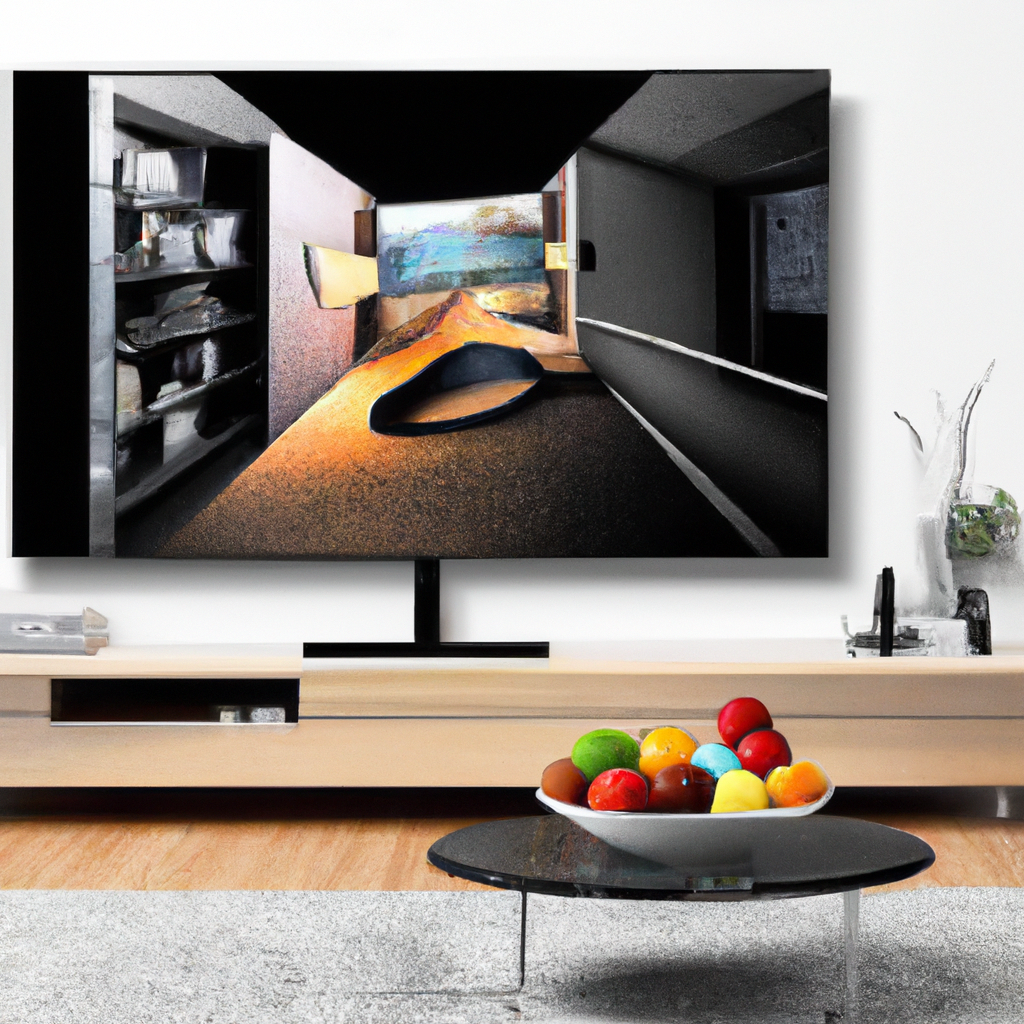
When it comes to buying a smart TV, there are a few key features that you simply can’t afford to overlook. From screen size and resolution to connectivity options and smart capabilities, each aspect plays a crucial role in enhancing your viewing experience. So, if you’re in the market for a new TV and want to make an informed decision, we’ve got you covered. In this article, we’ll break down the essential features you should consider, ensuring that you find the perfect smart TV that suits your needs and preferences.

Display
Screen size
When it comes to choosing a smart TV, one of the first factors to consider is the screen size. The size of the TV will greatly impact your viewing experience. A larger screen allows for a more immersive experience, especially when watching movies or playing video games. However, it’s important to consider the size of your room and the viewing distance. If you have a small living room or bedroom, a TV that is too big may overwhelm the space. On the other hand, if you have a large living room, a TV that is too small may not provide the desired viewing experience. It is recommended to measure the space where the TV will be placed and consider the optimal viewing distance before selecting the screen size.
Resolution
The resolution of a smart TV refers to the number of pixels that make up the screen. A higher resolution means a sharper and more detailed image. The two most common resolutions for smart TVs are Full HD (1080p) and 4K Ultra HD. Full HD resolution is suitable for smaller screens, while 4K Ultra HD offers a more refined and lifelike picture quality on larger screens. If you enjoy watching high-definition content or plan to use your smart TV for gaming, investing in a 4K Ultra HD TV would be a wise choice.
Picture quality
In addition to the resolution, the overall picture quality of a smart TV is determined by various factors such as the display technology, contrast ratio, and color accuracy. There are different types of display technologies available, including LED, OLED, and QLED. LED displays are the most common and provide good picture quality, while OLED displays offer deeper blacks and vibrant colors. QLED displays rely on quantum dot technology to enhance color accuracy and brightness. When choosing a smart TV, consider the display technology that best suits your preferences and budget.
HDR support
High Dynamic Range (HDR) support is an important feature to consider when buying a smart TV. HDR enhances the contrast and color accuracy of the picture, resulting in more vivid and lifelike images. HDR technology allows the TV to display a wider range of colors and highlights, making the viewing experience more immersive. Look for a smart TV that supports HDR formats such as HDR10 or Dolby Vision, as this will greatly enhance your enjoyment of movies, TV shows, and games that are produced in HDR.
Refresh rate
The refresh rate of a smart TV refers to the number of times the screen is refreshed per second. It is measured in Hertz (Hz). A higher refresh rate ensures smoother motion and reduces motion blur, which is particularly important for fast-paced action scenes and gaming. Most smart TVs have a standard refresh rate of 60Hz, but some models offer higher refresh rates such as 120Hz or even 240Hz. If you are a frequent gamer or enjoy watching sports or action-packed movies, consider opting for a smart TV with a higher refresh rate for a more seamless viewing experience.
Connectivity
Wireless options
One of the conveniences of a smart TV is its ability to connect to the internet wirelessly. Look for a smart TV that supports Wi-Fi connectivity, preferably with the latest Wi-Fi standards such as Wi-Fi 6 (802.11ax) for faster and more reliable connections. This will allow you to stream content, browse the internet, and access online services without the need for a physical Ethernet connection. Having wireless options also eliminates the need for messy cables and provides more flexibility in terms of where you can place your TV within your home.
Ethernet connection
While wireless connectivity is convenient, it can sometimes be prone to interference or slower speeds, especially if there are multiple devices connected to your Wi-Fi network. In such cases, having the option to connect your smart TV to your router via an Ethernet cable can provide a more stable and reliable internet connection. This is particularly important if you plan to stream 4K content or engage in online gaming, where fast and consistent internet speeds are crucial. Look for a smart TV that has an Ethernet port for this purpose.
HDMI ports
HDMI (High-Definition Multimedia Interface) ports are essential for connecting various devices to your smart TV, such as gaming consoles, Blu-ray players, soundbars, and streaming devices. When choosing a smart TV, consider the number of HDMI ports it offers. It’s always a good idea to have at least three or more HDMI ports to accommodate all your devices and prevent the need for constantly swapping cables. Additionally, look for a smart TV that supports the latest HDMI standards, such as HDMI 2.1, which allows for higher bandwidth and advanced features like Variable Refresh Rate (VRR) for smoother gaming.
USB ports
USB ports on a smart TV can be useful for connecting external storage devices, such as USB flash drives or external hard drives, to access and play media files directly on your TV. It can also be used to connect peripherals like keyboards or mice for easier navigation, especially if your smart TV offers web browsing functionality. Consider the number and type of USB ports available on the smart TV, as well as the compatibility with different USB standards. USB 3.0 ports are faster in transferring data compared to USB 2.0 ports, so prioritize a TV with USB 3.0 ports if you plan to utilize these features frequently.
Smart Features
Operating system
The operating system of a smart TV determines the user interface, app compatibility, and overall functionality of the TV. Popular operating systems for smart TVs include Android TV, webOS, Tizen, and Roku TV. Each operating system offers its own unique features and interface, so it’s important to choose one that aligns with your preferences and provides a user-friendly experience. Consider factors such as app availability, ease of navigation, and regular software updates when considering the operating system of a smart TV.
App compatibility
Smart TVs allow you to access a wide range of apps and streaming services directly on your TV, eliminating the need for additional devices such as media players or streaming sticks. When choosing a smart TV, ensure it supports the apps and services that you frequently use or plan to use. Look for popular streaming apps like Netflix, Amazon Prime Video, Hulu, and Disney+, as well as any specific apps or services you may require. Some smart TVs also offer the ability to download and install additional apps from an app store, providing even more flexibility in terms of content options.
Voice control
Voice control has become an increasingly popular feature in smart TVs, allowing you to control various functions using voice commands. This can range from basic commands like changing the channel or adjusting the volume to more advanced features like searching for specific content or controlling smart home devices. If you prefer a hands-free approach and want the convenience of controlling your TV through voice commands, look for a smart TV that supports voice control. Some smart TVs have built-in voice assistants like Amazon Alexa or Google Assistant, while others may require an external voice control device like a smart speaker.
Screen mirroring
Screen mirroring is a convenient feature that allows you to mirror the content from your smartphone, tablet, or laptop onto your smart TV screen. This enables you to display photos, videos, or presentations on a larger screen for a better viewing experience. Look for a smart TV that supports screen mirroring technologies like Miracast, AirPlay, or Chromecast, depending on the device you wish to mirror from. This feature can be particularly useful for sharing content during family gatherings or business presentations without the need for physical connections.
Web browsing
Some smart TVs offer web browsing capabilities, allowing you to surf the internet directly on your TV screen. This can be useful for searching for information, reading articles, or accessing websites that may not have dedicated apps on the TV’s app store. However, it’s important to note that web browsing on a TV may not provide the same smooth and responsive experience as on a computer or smartphone. Consider the user interface, ease of typing with a remote control, and the TV’s processing power when evaluating the web browsing capabilities of a smart TV.
Audio
Sound quality
While the visual aspects of a smart TV are important, audio quality should not be overlooked. The sound quality can greatly enhance your viewing experience, especially when watching movies or playing games that rely on immersive sound effects and dialogue. Look for a smart TV that offers good sound quality, preferably with technologies like Dolby Atmos or DTS Virtual:X for a more engaging audio experience. However, it’s worth noting that built-in TV speakers may not always deliver the best sound quality, so you may need to consider external speaker systems or soundbars for a truly immersive audio experience.
Built-in speakers
Most smart TVs come with built-in speakers that provide basic audio output. The quality and power of these speakers can vary between different models and brands. When choosing a smart TV, consider the speaker configuration, wattage, and any additional audio technologies or enhancements. Some smart TVs have multiple speakers or subwoofers built-in, providing a more robust audio output. However, if you are an audiophile or desire a more theater-like experience, investing in an external sound system or soundbar would be recommended for superior sound quality.
Audio output options
Smart TVs offer various audio output options to connect external audio devices for an enhanced audio experience. Look for a smart TV with multiple audio output options such as HDMI ARC (Audio Return Channel), optical audio out, or a headphone jack. HDMI ARC allows two-way audio communication between the TV and a soundbar or AV receiver, eliminating the need for a separate audio cable. Optical audio out is another popular option for connecting soundbars or home theater systems. Having these audio output options gives you the flexibility to choose the best audio setup according to your preferences and requirements.
Surround sound support
If you enjoy watching movies or playing games that utilize surround sound, it’s important to ensure that the smart TV supports surround sound technologies. Look for a smart TV that is compatible with popular surround sound formats such as Dolby Digital or DTS. This will allow you to connect external speakers or home theater systems that support surround sound, providing a more immersive and theater-like audio experience. Some smart TVs also have built-in virtual surround sound modes that can simulate the effect of surround sound without the need for additional speakers.

Design
Thin bezels
The design of a smart TV plays a significant role, not only in aesthetics but also in maximizing the screen real estate. Thin bezels refer to the narrow borders surrounding the display. TVs with thin bezels provide a sleek and modern look, as well as a more immersive viewing experience by minimizing distractions around the screen. When choosing a smart TV, consider the bezel size and opt for models with thinner bezels if you prefer a more stylish and visually appealing design.
Slim profile
A smart TV with a slim profile can be an advantage, especially if you plan to mount it on the wall or place it in a tight space. Slimmer TVs take up less space, blend better with the room decor, and provide a more streamlined look. Additionally, a slim profile often indicates a lightweight and more portable TV, which can be beneficial if you plan to move or rearrange your setup frequently. Consider the thickness and weight of the TV when evaluating its design and portability.
Sturdy build
Although a slim and lightweight design is desirable, it’s essential to ensure that the smart TV has a sturdy build quality. You want a TV that feels solid and durable, capable of withstanding the test of time. Opt for smart TVs that are made with high-quality materials and have a reputation for durability. Reading customer reviews and checking the build quality before making a purchase can provide insights into the TV’s longevity and overall reliability.
VESA mounting compatibility
If you plan to mount your smart TV on the wall, it’s crucial to check its VESA mounting compatibility. VESA (Video Electronics Standards Association) is a standardized pattern for mounting TVs and monitors, consisting of four mounting holes on the back of the TV. Different TV sizes have different VESA patterns, so ensure that your smart TV’s VESA pattern matches the VESA pattern of the wall mount you intend to use. This will ensure a secure and proper installation, allowing you to enjoy your TV without any worries about stability or safety.
Remote Control
Ergonomics
The remote control of a smart TV is your primary tool for navigating through the interface, adjusting settings, and controlling the TV’s functions. Therefore, it should be comfortable and easy to use. Look for a remote control with an ergonomic design that fits well in your hand and has well-placed buttons for easy reach. Consider factors such as button size, placement, and overall feel when evaluating the ergonomics of a smart TV remote control. Some models even offer additional features like backlighting for better visibility in low-light conditions.
Button layout
A well-designed button layout is essential for a user-friendly experience with a smart TV remote control. The buttons should be logically organized and labeled clearly for easy navigation. Look for a remote control that has dedicated buttons for frequently used functions like volume control, channel selection, and playback controls. Additionally, some smart TVs offer remotes with dedicated buttons for specific apps or streaming services, allowing you to quickly launch your favorite apps with a single press. Consider your personal preferences and frequently used functions when assessing the button layout of a smart TV remote control.
Smart features integration
With the advancement of smart technology, remote controls for smart TVs have evolved to include additional features and integration with other smart devices. Some smart TV remotes offer built-in voice control, allowing you to use voice commands to control the TV and other compatible smart home devices. Others may have dedicated buttons or shortcuts for popular smart features like screen mirroring or accessing streaming services directly. Consider the integration of smart features in the remote control and choose one that aligns with your technological preferences and requirements.
Voice control
As mentioned before, voice control is becoming a common feature in smart TVs and their remote controls. If you prefer the convenience of controlling your TV through voice commands, ensure that the smart TV remote control supports voice control. Look for remotes with built-in microphones or the ability to connect to voice control devices such as smart speakers. Voice control allows you to search for content, change channels, adjust settings, and perform various functions without having to navigate through menus manually. It is especially convenient when you have your hands full or when you want to quickly access specific content.

Price
Budget
When buying a smart TV, it’s important to consider your budget and find a TV that offers the best value for your money. Set a realistic budget range based on your requirements and preferences, and look for smart TVs that fall within that range. While budget smart TVs may not have all the advanced features and latest technologies, they can still provide a satisfactory viewing experience with essential smart features. Consider factors like screen size, resolution, connectivity options, and overall functionality when evaluating whether a budget smart TV meets your needs.
Mid-range
Mid-range smart TVs offer a balance between quality and affordability. They often provide a wider range of screen sizes, higher resolution options, and more advanced features compared to budget models. Depending on your preferences and requirements, a mid-range smart TV can provide a great viewing experience without breaking the bank. Look for smart TVs from reputable brands in this price range, as they often offer better build quality, customer support, and after-sales service. Consider the specific features and technology advancements you desire, such as HDR support or higher refresh rates, when exploring mid-range options.
Premium
Premium smart TVs are the pinnacle of technology and offer the latest advancements in display quality, audio performance, and smart features. These high-end models often come with larger screen sizes, higher resolutions, support for advanced HDR formats, and a wide range of connectivity options. If you’re a tech enthusiast, avid gamer, or simply want the best viewing experience available, investing in a premium smart TV might be the right choice for you. However, it’s important to note that premium smart TVs come with a higher price tag. Consider your budget, desired features, and long-term usage before committing to a premium smart TV.
Streaming Services
Supported platforms
Most smart TVs support popular streaming platforms like Netflix, Amazon Prime Video, Hulu, and Disney+. However, it’s essential to check if the smart TV you are considering offers support for the specific streaming services you use or plan to subscribe to. Look for compatibility with the streaming platforms that provide the content you enjoy the most. Some lesser-known or specialty streaming platforms may not be available on all smart TVs, so it’s important to investigate the app availability before making a purchase.
App availability
Apart from the streaming platforms, the availability of other apps on a smart TV’s app store can greatly enhance the entertainment options. Check if the smart TV offers a wide selection of apps for different purposes, such as news, sports, music, or lifestyle. Consider specific apps that you frequently use or would like to have on your TV, and ensure they are available on the smart TV’s app store. Additionally, look for smart TVs with the ability to download and install apps from external sources, as this provides even more flexibility in terms of content options.
Content providers
In addition to the streaming platforms and apps, it’s worth considering the availability of content providers on a smart TV. Content providers refer to websites or services that offer on-demand content, live TV, or even user-generated content. Examples include YouTube, Vimeo, Twitch, or even local news websites. Look for a smart TV that supports the content providers you enjoy or regularly visit. This allows you to access a wider range of content directly on your TV, eliminating the need for additional devices or subscriptions.

Gaming
Input lag
Input lag is a crucial factor to consider when buying a smart TV for gaming. Input lag refers to the delay between pressing a button on your gaming controller and the corresponding action being displayed on the TV screen. High input lag can negatively impact your gaming experience, leading to delayed responses and decreased accuracy. Look for a smart TV with low input lag, ideally below 20 milliseconds (ms), for a smooth and responsive gaming experience. Some smart TVs also offer dedicated gaming modes or features that further reduce input lag and optimize the visual settings specifically for gaming.
Game mode
Game mode is a feature available on many smart TVs that optimizes the display settings for gaming. When game mode is enabled, it typically reduces input lag, enhances motion handling, and disables certain image processing features to provide a more responsive and immersive gaming experience. This feature is especially important for fast-paced games or competitive gaming, where quick reactions and accurate timing are crucial. When choosing a smart TV for gaming, look for one that offers an effective game mode to ensure optimal performance and responsiveness in your gaming sessions.
Refresh rate
As mentioned earlier, the refresh rate of a smart TV is important for gaming. A higher refresh rate allows for smoother motion and reduces motion blur, enhancing the overall gaming experience. When playing fast-paced games, a higher refresh rate can make the action feel more fluid and responsive. Look for a smart TV with a refresh rate of at least 120Hz, especially if you play a lot of action games or competitive multiplayer games. Some smart TVs even offer refresh rates of 240Hz or higher for an even more seamless gaming experience.
Variable refresh rate (VRR)
Variable Refresh Rate (VRR) is a feature that syncs the refresh rate of the TV with the output from your gaming console or PC, resulting in smoother gameplay and eliminating screen tearing. VRR is particularly important when playing games with varying frame rates, as it ensures a consistent and artifact-free experience. Look for a smart TV that supports VRR technologies like AMD FreeSync or NVIDIA G-SYNC if you want to take full advantage of this feature. VRR can greatly enhance your gaming experience by providing a more stable and immersive gameplay environment.
Warranty and Support
Manufacturer warranty
When purchasing a smart TV, it’s important to consider the warranty offered by the manufacturer. Most smart TVs come with a standard warranty that covers defects in materials and workmanship for a certain period of time, usually one to three years. A longer warranty period indicates the manufacturer’s confidence in the product’s reliability and can provide additional peace of mind. Read the warranty terms and conditions carefully to understand what is covered and any limitations or exclusions that may apply.
Extended warranty options
Some retailers offer extended warranty options for smart TVs, providing additional coverage beyond the manufacturer warranty. Extended warranties can be beneficial if you want extra protection or peace of mind for a longer period. However, it’s important to carefully evaluate the cost versus the potential benefits of an extended warranty. Consider factors such as the overall reliability of the smart TV, the cost of the extended warranty, and your intended usage and duration of ownership. Make an informed decision based on your individual circumstances and preferences.
Customer support
Lastly, consider the level of customer support provided by the manufacturer and retailer. It’s important to have access to reliable customer support in case you encounter any issues or have questions regarding your smart TV. Look for manufacturers and retailers with a reputation for responsive and helpful customer support. Online reviews and customer feedback can provide insights into the quality of customer support offered by different brands and stores. A prompt and knowledgeable customer support team can make a significant difference in resolving any concerns or providing assistance throughout the lifespan of your smart TV.






